S u m m a r y
|
| Title, Description &
Publisher: |
Buzz Numbers - The Explanation and
Regulations Behind America's Military Aircraft Identification System
by Peter M. Bowers and David W. Menard |
| ISBN: |
978-1-58007-103-1 |
| Media: |
Soft Cover; 11.5 x 9" format;
96 pages; around 300 black and white photos throughout |
| Price: |
USD$16.95 from Specialty Press |
| Review Type: |
First Read |
| Advantages: |
The definitive reference for the
Buzz Number code system for US military aircraft; logically laid out;
clearly described in text, photos and tables; detailed Appendices with
copies of actual technical orders and regulations |
| Disadvantages: |
|
| Recommendation: |
Recommended |
Reviewed by Brett Green

HyperScale is proudly supported by
Squadron.com
 "Buzz
Numbers" is the identification system that was used for US Army and US
Air Force aircraft from late 1945 until the mid-1960s. This was a
combination of two earlier identification systems - individual aircraft
serial numbers, and fiscal year serial numbers. "Buzz
Numbers" is the identification system that was used for US Army and US
Air Force aircraft from late 1945 until the mid-1960s. This was a
combination of two earlier identification systems - individual aircraft
serial numbers, and fiscal year serial numbers.
From 1942 onwards, prominent numbers began appearing on the tails of
US Army aircraft. These tail numbers were abbreviated versions of longer
fiscal year numbers, which included information about the year of
manufacture, the aircraft type and the individual aircraft number. They
also doubled as the aircraft's radio call number.
After Allied victory in Europe, Eighth Air Force frequently pilots
"buzzed" the countryside. Ground observers needed a way to easily
identify these aircraft, hence the "Buzz Number" system was created to
catch these miscreants.
The Buzz Number scheme comprised two letters to identify the aircraft
type (eg P for pursuit) and model (eg A for P-38), followed by a dash
and the last three digits of the tail number.
The authors have created a very useful reference covering the history
and development of Buzz Numbers and their application. The book
commences with a summary of systems in place prior to Buzz Numbers,
followed by a description of the new system and its implementation. The
next eight Chapters outline the application of the two-letter Buzz
Number system, laid out by aircraft type - fighters, bombers, cargo,
pursuit, trainers and miscellaneous.
The remaining six Chapters explains some of the specialist units and
exceptions, including the three-letter Buzz Numbers, US Air Force (and
USAF) markings, National Insignia and Air National Guard.
The book is wrapped up with tem Appendices. These are copies of
original technical orders and regulations, providing first-hand insight
into the implementation of this system.
The book is liberally illustrated with around 300 captioned
contemporary black and white photos as marking examples. The system is
are further explained using helpful tables.
Although this subject might be expected to be dry, the authors have
actually delivered quite an interesting book that will be of great use
to modellers and historians as the definitive reference on the subject
of Buzz Numbers.
Recommended.
Thanks to
Specialty Press for the review sample
Review Copyright © 2006 by Brett Green
This Page Created on 02 October, 2006
Last updated 31 December, 2006
Back to HyperScale Main Page
Back to Reviews Page
|
Home | What's
New | Features
| Gallery |
Reviews | Reference
| Forum
| Search